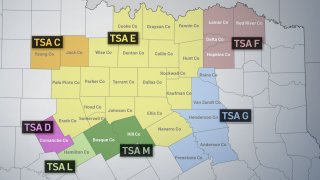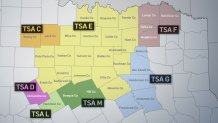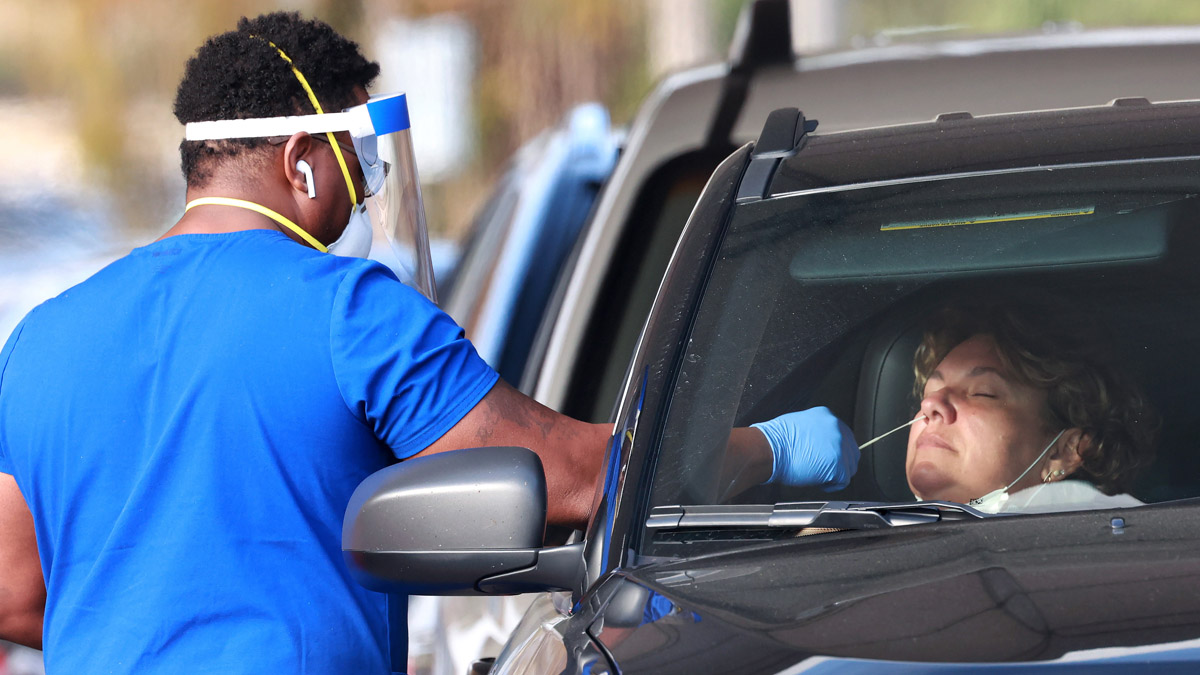
North Texas hospitals crossed a troubling COVID-19 threshold Thursday, and doctors aren’t convinced new restrictions will be enough to stop patient loads from overwhelming the health care system.
"If numbers continue to increase, we are going to have situations where we ultimately will not have an ICU bed available,” warned Dr. Mark Casanova, who serves on a panel of medical professionals advising Dallas County leaders on the pandemic. “Are we there today? No. When will we get there? It's hard to say, but that is something that is a very realistic probability on the horizon.”
New Restrictions Take Effect
In October, Gov. Greg Abbott (R) laid out a red line meant to keep Texas hospitals from breaking down.
When COVID-19 patients make up 15% or more of hospital capacity for seven straight days in a Trauma Service Area, businesses must begin rolling back capacity, bars must close, and elective surgeries must be suspended.
TSA E, which includes 19 North Texas counties, hit that mark on Nov. 3 and will remain under the restrictions until it drops below 15% for seven straight days.
The governor’s order forces businesses operating at 75% capacity to move to 50% capacity. That includes indoor dining at restaurants, retail stores, gyms and offices.
Bars and similar businesses also must close under the new restrictions. Many may remain open at 50%, however, because they met new criteria to be classified in the same category as restaurants by state alcohol regulators.
Effectiveness Questioned
Frontline health care workers like Casanova question whether those measures are enough.
“The slope of the curve is so steep right now, I'm not sure how much of an impact that just partial rollbacks will make at this time," he explained. "We have a choice before us: Do we want to get this under control? Do we want to take this seriously, do we want to try to expedite a return to normalcy or are we going to proceed with partial mitigation measures as we see these numbers steadily and sharply increase on a daily basis?”
What Needs to Be Done?
In November, the advisory panel urged tougher restrictions, warning if the necessary steps aren’t taken, hospitals’ ability to effectively treat COVID-19 patients will break.
That group recommended closing all indoor dining and shutting down bars, including some that reclassified in the restaurant category but continue to function as a bar.
"Does that affect disproportionately some settings? Yes, it does,” Casanova acknowledged. “Do we see them as being at fault? No, it's the virus that’s at fault. The problem is just the very human nature of behavior in those settings."
COVID-19 Latest
Casanova said the recommendations are based on what they learn from patients about their own exposures. They’re also calling for a limit of 10 people or fewer on all gatherings.
Personal responsibility and following guidelines will be crucial to cutting infections, said Dr. Robert Gullinese, an emergency department physician at Texas Health Harris Methodist in Fort Worth.
"We really need to do the things we know work,” he said. "Wearing your mask, watching your distance, staying at least six feet from others, washing your hands. Doing those simple things does make a difference."
Gullinese also worries about holiday gatherings as the weather turns colder and people move indoors.
“One person really can infect two or three other people,” he explained. “Even though you're with family, I'd implore the community just to assume a family member unknowingly has coronavirus.”
"It needs proximity. It needs air. It needs projection of a voice, a cough, a laugh,” echoed Dr. Casanova.
"It's a serious illness, much more serious than the flu. I just think that we respect it,” said Gullinese. “Especially for our older population and our baby boomers. They've given us so much as a generation, that this is sort of our time to give back to them."
The Emotional Toll
Casanova revealed it’s upsetting to see people ignore basic safety guidelines.
"I'll be really, frankly, honest with you: it's extraordinarily frustrating. It's disheartening and I think it’s weighed on many of us now nine months in."
"I see they’re thinking, 'I'm young. I'm healthy. I’m not going to get this, I don't need to worry about this,’” said Gullinese. “I'd implore them to think of their grandmother."
Both doctors say the pandemic takes an emotional toll, weighing heavily on hospital staff.

"Yes, death is inevitable, but many of the individuals that we have lost through this journey, many have been preventable, and many have been premature,” explained Dr. Casanova. "Death from COVID is one of the more arduous journeys I’ve borne witness to. Many patients can deal with pain to a certain degree. Those who say, ‘I can't breathe, I’m suffocating for air,’ that is a very different pathway through death and that is what we are trying to combat."
Despite the fatigue, their colleagues are determined to see this battle through.
"They're a resilient bunch,” said Gullinese of his colleagues in the emergency department. “It’s just amazing to me. It warms my heart to see them coming every day and putting forth their best effort every day despite that fatigue and really being in great spirits."
Nowhere to Turn
North Texas hospitals began implementing surge measures weeks ago, expanding ICU bed numbers. Gullinese said they have plenty of equipment and enough staff at the moment.
“We have surge plans in place, North Texas hospitals are more than able to care for these patients, we have all the supplies we need,” said Gullinese. “It does put a strain on human resources.”
"The problem is we don't have the staff to recruit,” Casanova cautioned. “We can't lean on another region in Texas. Texas is taxed. We can’t lean on another region in the nation, because the nation is taxed."
Get DFW local news, weather forecasts and entertainment stories to your inbox. Sign up for NBC DFW newsletters.
TSA-E became the state’s seventh region to hit the governor’s red line. El Paso and surrounding counties reached the mark in early October, trailed closely by the Amarillo and Lubbock TSAs. The Laredo, Midland-Odessa and Waco regions followed in November.
No region has emerged from the restrictions or even fallen below the 15% mark for a single day since activating them. The percentages have increased in most and more than doubled in some regions, including El Paso.
The governor’s office said there’s proof the restrictions are making a difference.
“"We've seen this work, as evidenced by the recent efforts in El Paso,” said Press Secretary Renae Eze, pointing to cases in El Paso County being cut in half over the past month.”
Gullinese wants to ensure concerns about the increases in COVID-19 numbers in North Texas don’t deter patients from seeking help. He encourages anyone who needs medical help to get care right away.
"I see patients who have put off their emergencies,” he said. “They tell me they did this because they were scared to go to the hospital and that's the wrong message. That’s not what it is like in the ED.”
Hope on the Horizon
The surge and accompanying restrictions come at the same time as promising vaccine developments.
"Are we frustrated, are we disappointed? Yes. Are we optimistic? Yes,” said Casanova. “We have a vaccine on the horizon, there is hope coming down the pike”
"This is actually the time we really need to be diligent. We need to double our efforts right now, not get relaxed thinking, ‘Oh, there's a vaccine coming soon we can let down our guard,” urged Gullinese. “This is the time … we bring everybody home safely to the finish line."


